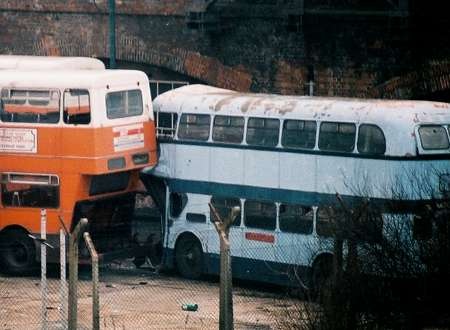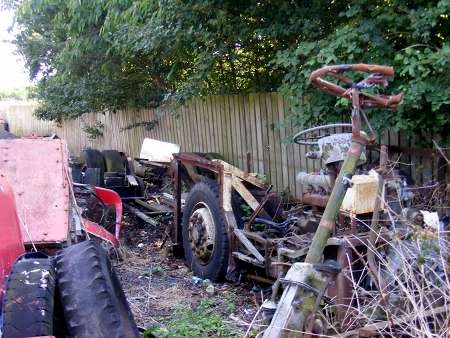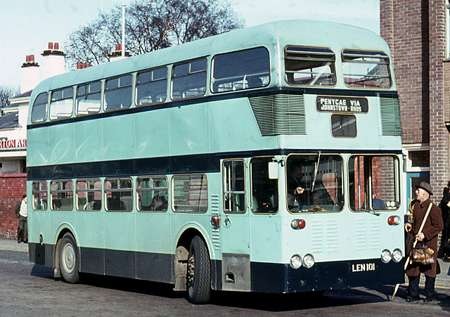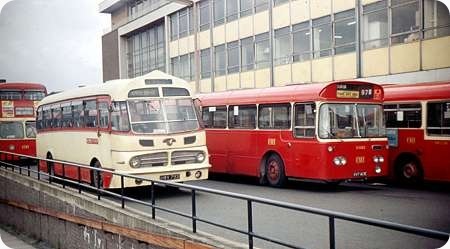Bury Corporation - Guy Wulfrunian - LEN 101 - 101
Bury Corporation
1961
Guy Wulfrunian
Roe H43/30F
LEN 101 was the solitary Guy Wulfrunian purchased by Bury Corporation in 1961.(Fleet number 101.) It
had Roe H43/30F bodywork, but carried a Park Royal manufacturers’ plate. This was to allow it to be
exhibited at the 1960 Commercial Motor Show; as the Roe stand already had enough exhibits, there being
strict limits on the number of vehicles each manufacturer was allowed to display. It had another unique
feature, three part platform doors. Bury Corporation ran the Wulfrunian for only three years, and for
much of this time it was relegated to peak hour use. It was sold to an independent operator in South
Wales, Howell and Withers, who painted it grey and white, but only operated it for a short time before
selling the bus to Wrights, Penycae in August 1964. Wrights operated it on their stage service into
Wrecsam for five years.. Wrights painted the bus into this attractive two tone blue livery. It was with
Wrights that I had my only ride on this bus. Eventually LEN 101 was sold again, this time to Berresfords
of Cheddleton, who operated the bus for only a few days. Apparently drivers complained about the heavy
steering; so proprietor Jim Berresford took it for a test drive, after which he dumped it in the field
behind the Depot, where this photo was taken.
The Wulfrunian was eventually rescued by a group of
preservationists from the Manchester area, with the intention of restoring it to Bury Corporation’s
light green and cream livery. It was parked in the yard at the rear of Manchester’s Hyde Road depot,
which was used for initial training by the PTE’s driving school. Sadly, one of the training buses
reversed into the Wulfrunian, and it’s body was written off.
Photograph and Copy contributed by Don McKeown
27/11/14 - 06:21
Apart from the grilles for the Cave-Brown-Cave system, the really fascinating thing about this bus is what on earth prompted Bury, a Leyland/AEC operator to plump for a Guy and without the Leyland engine option Guy offered. Further, how did the purchase slip past the Transport Committee.
Phil Blinkhorn
27/11/14 - 14:15
Looking at its one-off status and commercial motor show exhibit background, followed by Bury’s operational lack of enthusiasm, this may have been an offer that they couldn’t refuse, but then didn’t quite know what to do with it.
Stephen Ford
27/11/14 - 17:23
Further to Don McKeown’s post on the Bury Corporation Wulfrunian LEN 101, I
attach a picture of it after being damaged in the Training School yard at Manchester’s Hyde Road
Depot.
It was apparently a Mancunian which did the damage.
This picture is from my
collection and is not my copyright.
Stephen Howarth
28/11/14 - 06:41
I think it is easy to overlook the high level of interest shown in the
Wulfrunian at the time of its introduction. Operators were looking for a forward entrance high
capacity bus but there was a lot of nervousness about the rear engine concept offered in the
Atlantean. The two demonstrators were kept very busy and appeared with many of the large operators.
Bury was just about to start on a major fleet update to replace their fleet of early post-war
PD1’s and PD2’s and 101 was probably bought as a test bed for a potential replacement vehicle. They
could have saved a lot of money and heartache if they had taken one of the demonstrators for a
spell.
I remember 101 with Bury and it seemed to spend most of its life parked by the doorway
of the Rochdale Road garage. I was told by one of the fitters that it was disliked by drivers
because of the heavy steering and very cramped cab. I did see it in service on the 9 (Jericho -
Tottington) and 37 (Walmersley - Whitefield) occasionally.
It is a great pity that it was
damaged in the collision at Hyde Road as despite its failings, it was a key part of the transport
heritage of the north west. I believe the chassis still exists at Dewsbury Bus Museum. Can anyone
confirm?
Philip Halstead
28/11/14 - 06:46
The chassis still survives, and is currently parked among undergrowth at a preservation site near Selby, where it is owned by Mr. Ian Hunter of Leeds. The above photo shows the chassis as it was in the summer of 2014.
Don McKeown
28/11/14 - 14:36
I am pleased to see that this rare chassis still survives, I hope it can be restored before it rusts away. I’m sure the steering will not feel so heavy without the bodywork.
Ron Mesure
29/11/14 - 07:16
I’ve got it in my head that Wright’s of Penycae were not the second Welsh
independent to operate LEN 101, but the third. I could even suggest a third operator’s name - can
anyone confirm?
As to why Bury didn’t insist on the use of one of the demonstrators (are we
sure they didn’t have one?), the borrowing of a manufacturer’s demonstrator wasn’t something which
was as easy as people probably imagine. A manufacturer needed to be sure there was an order in the
offing before a demonstrator became a possibility. I have actually been in an operator’s office when
the operator asked the rep if there was any possibility of having a vehicle on demonstration, and
the response was an emphatic ‘no’.
As to whether the use of a demo would have helped
depends upon how quickly the Wulfrunian’s failings made themselves felt. In view of how quickly
operators generally disposed of them the answer would appear to be, very quickly indeed, yet West
Riding continued to buy them until 1965.
Were West Riding simply stubbornly reluctant to
admit they’d made a mistake, or were they obliged to buy a certain number as part of the original
deal?
David Call
30/11/14 - 06:33
I remember in the 60`s Bury did have an Atlantean from Coventry, it was in the colours of Coventry, Blue with a white band. It was a surprise as I was going home from my then girlfriend from Bolton to Bury, I remember the driver telling me it was on loan from Coventry. I remember LEN 101, it seems a shame lying in the under growth with no body.
David Henighan
30/11/14 - 09:55
I know you can’t always rely on Wiki, but, the Wulfrunian article on there says that it was developed jointly by Guy and West Riding.
John Lomas
01/12/14 - 07:12
If that was the training bus that did the damage, then I’m hardly surprised that the poor trainee didn’t have full control of the Macunian. From the photo, it doesn’t look as though it’s got an engine !
Petras409
01/12/14 - 07:13
Referring to Philip Halstead’s post, scroll down here for several views of LEN 101 including one in colour of the bus on the 37 Whitefield. //jsh1949.co.uk/GUY%20WULFRUNIAN.htm
John Darwent
01/12/14 - 07:14
In the book ‘Forgotten Double Deckers’ by David Harvey there is a
section on the Guy Wulfrunian and a piece that reads:
Quote
The Development of the
"Wulfrunian"
Guy Motors were going to be left behind in the race to develop an
up-to-date low height 30′ long chassis, until West Riding Motors of Wakefield, at the
instigation of their chief engineer, Ron Brooke, approached Guys with an advanced specification for
such a chassis.
Unquote
David Slater
01/12/14 - 07:15
In the mid 1950s, following the lead of General Motors in the USA, whose GMC type 4104 air suspended Scenicruiser had been adopted by Greyhound from 1953, Guy Motors became convinced that the future for successful passenger chassis sales lay in air suspension. This initial interest led to the underfloor engined Victory, which had air suspension all round, independent at the front, and air hydraulic disc brakes. The first Victory appeared in 1958, and during the model’s development, Ron Brooke, the Chief Engineer of West Riding, approached Guy with the idea of a low frame double deck chassis incorporating the air suspension features of the Victory, but employing a simple, straight drive line from a front mounted engine. This, it was thought, would give a reliable drive line and permit the entire interior of the lower deck to be used for passenger accommodation. At this time the early Atlanteans were suffering extreme problems with their rear engines/gearboxes and angled drive lines. It would seem that he had hawked his ideas round other manufacturers to no avail (I bet that all those sceptical makers breathed huge sighs of relief when the Wulfrunian’s troubles came home to roost). West Riding was a confirmed user of Gardner engines in its Arab fleet, and the 6LX was chosen as the power unit of the new Wulfrunian. Though not a heavy engine in comparison with its contemporaries from other UK manufacturers, the 6LX was physically large, and positioning it as far to the offside as possible to allow a respectable platform area resulted in a very narrow cab and footwell. To add to the driver’s woes, his/her left leg was unavoidably positioned hard against the engine cover panel, on the far side of which was the Gardner’s offside exhaust assembly. Because of the substantial weight at the extreme front of the overhang, the front wheels had a remarkable negative camber that contributed to the very heavy steering characteristics. The shrouding by the bodywork of the disc braking system sometimes caused the hydraulic fluid to boil, leading to a frightening loss of response. The subsequent history of the Wulfrunian’s operational career is well known, but it is surprising that the deficiencies of the design were not recognised and acted upon in the prototype stages. Looking at the chassis diagrams, it would seem that an answer might have been found by following the AEC ‘Q’ concept, and repositioning the engine to the offside close behind the front wheels. The transmission line would have had to be moved a bit, but the rest of the chassis could have stayed the same. The use of full air rather than air hydraulic for the brakes would have sorted out the braking problem at a stroke. Several modifications were made during the production run to try to fix the problems that arose, but the firm just ran out of money. We now know that Guy was already in severe financial difficulties at this time, following its agency debacle in South Africa, so it just stuck with a flawed design that had gained definite orders from West Riding, and turned a blind eye to the inevitable outcome.
Roger Cox
01/12/14 - 09:55
Petras409, either the photo or Stephen’s comment is misleading. The Training School used a variety of vehicles. Those on the public roads were normally dedicated vehicles, permanently marked with L plates. Within the grounds at Hyde Rd, this wasn’t always the case. It very much looks as if the GMT vehicle has done the damage. If so it looks as if it was a withdrawn vehicle being used ad hoc for basic training which has had its engine removed after the event, but it is a SELNEC/GMT Standard, not a Mancunian.
Phil Blinkhorn
01/12/14 - 14:07
A fascinating tale, Roger: the sad bit is that the design could have been
developed in the way that you suggest: sitting in a modern megabus makes you itch to make use of the
space under the stairs! You can see now the fundamental flaws in the Wulfrunian design caused by the
desire to get a bulky engine, a driver, a staircase and a passenger platform in to 8ft. The
curiosity is whether the driver was protected by the engine or couldn’t get into the saloon direct
to deal with troublemakers: perhaps a good thing! We were in a time when men were men and standing
up to turn the steering to full lock not unknown- but plonking all that weight at one end in the
overhang was possibly worse than plonking it at the back. All would have been solved with your Q2
with a touch of Lodekka, perhaps.
What a link, John D to pics of so many Wulfrunians. Did Roe
body all the "standard" ones? The Accrington version would have been a good test-bed for a
lot of the technology without the overhang problems. Did the Victory have the same sort of problems?
And what happened to all those West Riding Wulfrunians- straight to scrap with engines, too?
Joe
02/12/14 - 05:26
Joe, from reports I have read, most if not all of West Riding’s Wulfrunian engines (Gardner 6LXs) went into the ‘Wulfie’ replacement Daimler Fleetlines.
Brendan Smith
02/12/14 - 08:48
Brendan: I wondered about that… the subsequent West Riding VR’s used to gurgle like the Wulfrunians: why did West Riding buy up all those Wulfrunians? To get a load of cheap engines!
Joe
02/12/14 - 14:06
One of the perceived advantages of the Wulfrunian layout was the availability of the entire lower saloon for passenger accommodation. It was rather ironic that, when the excessive front end loading difficulties arose, West Riding removed the upper deck seats in front of the staircase, and barred off that area completely, thus totally negating the extra seating downstairs.
Roger Cox
09/12/14 - 06:17
I followed John D’s link above and….
At the risk of offending
anyone on here, I think the only comment I’d make is that the Accrington rear entrance Wulfrunians
(picture on John’s link Fleet Number 157 / Registration 36 VTF) deserve an honourable mention on the
Ugly Bus Page !!
Stuart C
09/12/14 - 11:56
I’m a fan of East Lancs products (having lived in Stockport for many years that’s a given!) but will accept your nomination and would ask our leader to do the necessary!!
Phil Blinkhorn
10/12/14 - 06:21
Stuart C/Phil: I’ve seen worse- looks better as sold on with the
"radiator" panel contrasted. See this link.
If you are putting this bus into Room 101,
then you may have to add a BMMO D type- but which one? D7?
But then the D10 is the Wulfrunian
that might have been…
Joe
11/12/14 - 06:32
Not the D7, Joe, but the D5, which, with its droopy, sad expression always suggested that it was about to burst into tears. I think that it would take quite a leap of the imagination to visualise the Wulfrunian metamorphosing into the D10:- low floor/high floor, front engine /underfloor engine, air suspension/rubber suspension etc.
Roger Cox
07/01/15 - 09:40
Here’s LEN 101 operating for Wrights, loading up in Wrexham Bus Station for Penycae just before 5 pm on 12 April 1969.
Tim Jeffcoat
14/12/15 - 06:22
I always thought most of the Wulfrunian’s failings could be addressed in the
following ways:
1) Air operated drum brakes.
2) Steel suspension: At front:
Routemaster, unequal wishbone with spring over shockers set up, with the addition (if room) of
torsion bars to stiffen the whole thing up and the ability to adjust ride height. With this
arrangement front wheel camber angles could have been normalised. On the rear: The coil spring set
up as on the F series Bristol Lodekka.
3) Power steering (the contemporary Routemaster had
it).
4) ASAP an 8’2 and a half" body, to give the driver.
Put all that together,
although front brake and tyre wear are always going to be heavy with this set up, a it might have
been largely OK.
James Fawcett
14/11/19 - 05:47
I used the 37 Bus to and from my home in Walmersley, as I as in school in Bury
( Bury GS). I remember the Wulfrunian well and often wondered what happened to it. Very sad, now I
know!
Also, I vaguely remember ( the memory isn’t what it used to be!) an AEC Bridgemaster
"on trial" around the same time and alsio used on the 30/37 route. Am I wrong?
PS
Loved to ride on the two AECs BEN 176 and 177 and pleased one has been preserved. Loved that AEC
engine whine!
Al
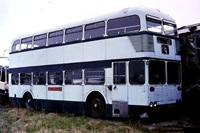 Vehicle reminder shot for this posting
Vehicle reminder shot for this posting
03/08/20 - 06:41
I travelled on LEN 101 to school whilst it was with Bury Corporation and invariably it meant I arrived late for school as the drivers did not like the heavy steering and therefore always seemed to lose time which they could not make up. I seem to remember that it was also owned by Byley Motors in Cheshire for a while at some stage after Bury sold it out of service.
Don Butterworth
Quick links to the - Comments Page - Contact Page - Home Page

